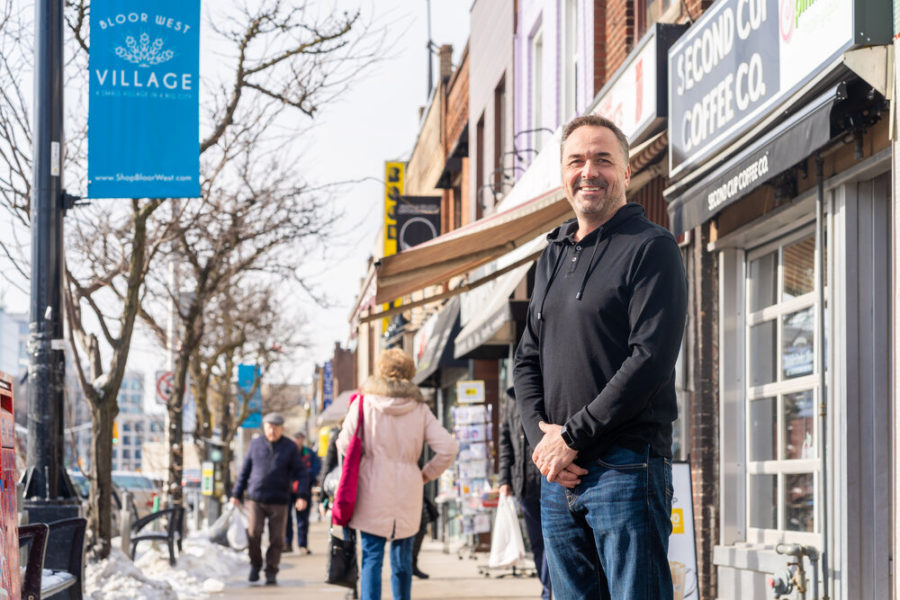
It’s impossibly cold out, David Howitt’s just torn up the floor in the basement of Marlborough’s, the 98-year-old stationery and school supply shop he runs alongside his wife Joanne, to fix a pipe situation and yet, the volunteer chair for the Bloor West Village BIA is beaming. Before he speaks he pulls up a video on his laptop and flips the screen around, pressing play with a “check this out” grin.
In the video the streets are alive (though, not dissimilar to the scene on display, even in the dead of winter outside on a Wednesday morning they still seem to be alive). The camera dips in and out of the myriad mom and pop shops lining the BIA’s stretch of Bloor Street between Jane Street and Ellis Park Road, before ending with a drone shot rising up above giving way to the Bloor West Village logo.
Howitt loves it. He’s proud of his neighbourhood. And the video is convincing. Not a single business’ sign is shown, and yet, you don’t need to wait to the end to know where you are.
“For the past few years – 2018 and 2019 – Bloor West Village has been ranked the number one neighbourhood in Toronto,” says Howitt. Again: proud.
This year, the Bloor West Village BIA turns 50. And by proxy, since it was the first Business Improvement Area in the world, the whole BIA program (of which Toronto has over 80 BIAs for its distinct neighbourhoods) turns 50 too.
Consider that: half a century ago, business owners in the area pooled their resources and volunteered their time to collectively brainstorm ways to compete with the newly-built Cloverdale Mall. Howitt loves the history. Marlborough’s itself has been in Joanne’s family since 1967 and Howitt and his wife have owned it since 1997. But more than history, he loves what’s next – that endless intrigue towards innovation.

“I’m heavily into technology,” says the BIA chair, who also consults businesses on strategic innovation. “I’m always thinking about how you bring in technology to make it easier and more efficient and broaden that package of things you can do.” At 50, the BIA, which has 400 members, is well over the hill, and yet, it plays with technology like a teenager.
Howitt likes to say he’s only the figurehead, that it’s his volunteer board getting things done and as the chair he’s lucky enough to get the credit pinned to him. “I have a strong board and committees that have amazing ideas,” he says. But under his guidance, those ideas have quickly turned into living, breathing experiments in the neighbourhood.
During his five year tenure, he’s focused his efforts on what he sees as the biggest threat to main street business: Amazon. “People look for things online first before they come out,” he says. “Our stores may have the things they’re looking for… we need to educate people that what they’re looking for is here.”
And that, says Howitt, is done by playing nice with Google’s algorithm. The BIA has worked with individual businesses to get their products online. “Rather than the stores individually logging their items online, we went in with an iPad, took photos, did the description, did all the work and put it up.” The volunteers also tirelessly worked to get all the businesses listed online through a neighborhood directory. The directory allows local shoppers to browse and buy online, check-in, leave reviews, and connect with local businesses.

“That was one of the things that I’m most proud of… to understand our competition and how to leverage it to our expertise,” says Howitt. The digital directory has led to a huge influx of online traffic to Bloor West Villages. But Howitt has also found a way to capture usable metrics on foot traffic in the neighbourhood as well via PeopleFlow, a platform that assigns anonymous tags to phones and tracks movement. Through the platform they learned a lot about foot traffic and gleaned some major insights like that between 6pm to 7pm is one of the busiest times on the street, yet a lot of businesses were closing before then.
“We were able to tell our membership, ‘hey, you need to be open a little bit later because that’s when people are physically in the street,’ ” says Howitt. They also used the platform to track the success of BIA events like the Ukraine Festival. “Now that we have three years of that data, we can tell you that 60 per cent of the people that attend the Ukrainian festival are regular shoppers in our area throughout the year,” he says. Before PeopleFlow it was anyone’s guess.
Then there’s the streetlights which are motion triggered and can feedback data on movement at all hours and offer up valuable information for safety in the area. It’s all part of a wider plan to make the world’s oldest BIA one of the most innovative. And that’s something Howitt is comfortable throwing his time at. Especially when they’re seeing results.
“If you want something done? Give it to a busy person… because they’re organized,” says the chair with a laugh. “I have strong will about how I see things… I got involved because I had so much insight and it wasn’t hard for me to do.”
Source: www.kickstartbia.com